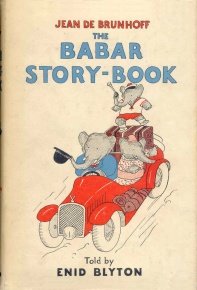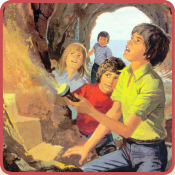
The Babar Story-Book

Book Details...
First edition: 1941
Publisher: Methuen
Illustrator: Olive F. Openshaw
Category: One-off Novels
Genre: Fantasy
Type: Novels/Novelettes
Publisher: Methuen
Illustrator: Olive F. Openshaw
Category: One-off Novels
Genre: Fantasy
Type: Novels/Novelettes
On This Page...
Reprints

Endpapers from the 1st edition, illustrated by Olive F. Openshaw
Babar grows up in the Great Forest and learns all the things that elephants need to know. He enjoys playing games of 'Catch' and 'Follow-My-Leader' and cavorting with his friends in the pond where they swim around and use their long trunks to squirt each other ... yes, the young elephants lead full and happy lives. One day when Babar's mother is clumping through the woods piggy-backing her young son a hunter raises his gun and shoots her dead! What a shock for Babar. He cries bitterly by his mother's side and then, heeding a warning from a monkey and some birds, he starts running for his life leaving behind him the Great Forest and all the things he knows and loves. He reaches a town and an elderly and very rich lady who likes elephants sees him, takes out her purse, and offers it to him so that he can buy some clothes and she also extends an invitation to dine at her place. Babar finds a big shop and purchases a shirt, tie, coat, trousers, shoes and even some spats and after he's donned his new duds he visits his lady friend for dinner and she says he can stay with her if he likes. This suits Babar very much and he accepts the invitation gladly. They get on well together because the old lady is very considerate and can't seem to do enough for her great big friend. She buys him everything he wants — even a car, and they travel all over the place with Babar asking so many questions about things that she eventually gets him a tutor.
After a couple of blissful years, Babar and the old lady are strolling downtown when the elephant spots his two little cousins — Arthur and Celeste, and what a pleasant reunion that is. He takes them to an outfitter and buys them some lovely clothes and then they visit a cake shop for the best tea the two cousins have ever had in their lives. Their mothers aren't too happy though with the disappearance of their progeny so they visit the town, search out their children and berate them sternly. Babar then becomes a little homesick and wants to go back with his cousins for a visit so with plenty of warm 'Goodbyes' to the generous old lady, they set off in Babar's car back to the Great Forest with the two mother elephants following behind.
On that very day the King of the Elephants comes across an exciting-looking toadstool, eats it, and is poisoned to death. That's a couple of rather brutal killings so far and it's not like Enid Blyton because little of that sort of thing exists in her writings but she's not the original author of course — just doing her duty as capably as she always does. When Babar arrives back at the Great Forest with his cousins, Cornelius the oldest elephant suggests that their long lost friend should be King because he's worldly and very knowledgeable seeing he's been to the big town and learnt all kinds of things. The other elephants agree with the proposition and Babar who has also fallen in love with his cousin Céleste is happy to accept the role and preparations are made for a the coronation/wedding and what a wonderful occasion it is with all the animals in the Great Forest attending.
God Save The King! Long Live The King!
The book contains six episodes in Babar's busy life and the second one deals with his and Céleste's honeymoon in which they set off in a balloon of all things and encounter savages on a remote island but they manage to use their strength and wits to advantage. They experience a ride on a whale and are picked up by a large boat but the captain just won't believe that his new passengers are a King and a Queen. They are relegated to the stables area and they're not too happy about that and even less happy when the captain gives them to Fernando who is a famous animal trainer at a circus. The two elephants are taught some tricks and routines but although it's quite pleasant appearing in the ring and being clapped they long for their freedom again and when the circus eventually visits the town where Babar's elderly lady friend lives they manage to sneak away one night leaving Fernando and the circus life behind them. The old lady is as accommodating as ever so the two refugees are quite safe from their former owner who carries out a fruitless search for his two stars. Life for Babar and Céleste becomes rosy once again and they go holidaying in the mountains with their host where they ski and skate and dance and on some afternoons they can even be spotted partaking of a horse-drawn sleigh ride.
Then there's a visit back to the Great Forest and the old lady accompanies them but horror greets their eyes. There has been a war on the elephants because of a trick Babar's cousin Arthur had played on Rataxes who is the leader of the rhinoceroses. The devastation is widespread and because the rhinos are going to attack again some plans are quickly drawn up for the defence and Babar introduces an excellent idea which is very successful. After that blip in the lives of the Elephant community Babar suggests that a town should be built by the lake and they all set themselves to the task. Houses spring up and two palaces are constructed — the 'Palace of Work' and the 'Palace of Pleasure'. The old lady has a dwelling built for her as well next to Babar's and Céleste's house and the settlement is named 'Célesteville'. There are presents for everyone following the town's completion and a big party is held at which the children sing the 'Song of the Elephants' for the King and Queen. Here is the first of three rather weird verses:
Patali dirapataThe party is a great success and afterwards the town thrives with everyone working hard in the mornings and relaxing in the afternoons. The elephant children attend school each day and everyone's very active and happy with little incidents described as the weeks roll by. Eventually a Great Fête is held with a procession at the start headed by Arthur and Zephir — the latter being a little monkey, and followed by the soldiers and the gardeners and farmers, cooks, bakers, painters, sailors, fisherman — all ready to have a jolly good time. What a wonderful year it is to look back on for the elephant populace although there are a couple of negative incidents as well such as when Babar's friend, the elderly lady, gets bitten by a snake and ends up in hospital. Then Cornelius' house catches fire so the brigade has to be called and the firemen (or fire-elephants) work hard to put it out. It was an unfortunate accident — Cornelius had lit his cigar and thrown the match into the wastepaper basket by mistake and now he has to join the old lady but they are both well looked after.
Cromda cromda ripalo
Pata pata
Ko ko ko
One of Babar's close friends in Célesteville is the little monkey, Zephir, who returns to his parents' home when the school holidays arrive. He's sad to leave them all but he does enjoy going on the train to The Town of Monkeys where the inhabitants live in little houses hanging from the trees because they like living amongst the branches. The chapter entitled 'Babar's Friend Zephir' deals mainly with Zephir's many relations and their activities ... Babar sends Zephir a sailing boat in which he goes fishing and accidentally catches a mermaid named Eleanor but he lets her go of course because he's a kind little monkey. I wondered with trepidation if Eleanor had been dragged up with the hook in her mouth but thankfully that did not happen — it caught in her hair so she had to swim upwards. On returning to Monkey town Zephir learns that Princess Isabel who is the daughter of a certain General Huc has been snatched away by a curious green cloud which descended upon her from above. An enormous search is conducted and Zephir joins in. He calls on Eleanor the mermaid to help and they experience quite an adventure because a monster called Polomoche is involved and he's backed up by other monsters so these summer holidays will be remembered by Zephir for a very long time. As you can see there's quite a lot that happens in this 225+ page book although the pictures pad it out a bit.
Babar and Céleste have triplets whose births are heralded by a cannon firing the appropriate number of times. The babies are loved by all and showered with flowers and other gifts and there's plenty of fuss and revelry which is only natural because they are the progeny of the King and Queen. The doctor has to visit and weigh the little elephants and after much thought they are christened Pom, Flora and Alexander. Later on there's a frightening episode where the three of them almost fall over a cliff when Arthur takes them out in the pram for an airing. He accidentally lets go of the handle and because it's on an incline the pram rushes away down the hill. Alexander is the unlucky one and he's ejected right over the side and a way has to be found to rescue him. Further on in the story there's an encounter with a crocodile when the incorrigible Alexander goes out on the river using Cornelius' bowler-hat as a boat. Babar then has to attempt a rescue and it turns out to be a very wet adventure for them both.
The final episode deals with Babar and his mission to find out why his children's letter to Santa Claus hasn't been answered. He leaves the Land of the Elephants and travels to the Land of Men somewhere in Europe. Acting on information received from some mice and then some sparrows Babar follows their directions but the supposed Santa's aren't the genuine article so he makes another attempt. The Babar stories are told in a kind of way that made me think the author simply made everything up as he went along — almost as if he was just following his nose. There's no reason why this method has to cause the story to pall because readers might enjoy the different tangents that are taken but it's almost as if the imaginative facility comes to a halt and something has to be thought up pretty quickly so a weird name might be created for a person or for a place and the new entity is briefly introduced ... a bookseller ... a Mr. Gillianez ... Professor William Jones ...
"Have you found Father Christmas yet?" ask some small sparrows of Babar.On and on from one to the other until Babar's search for Santa eventually bears fruit after a few adventures along the way. There's a large picture of Santa's cave near the end and it shows all the different rooms where the Great Man works and sleeps. Then comes a marvellous surprise for the inhabitants of Célesteville when Santa Claus honours them with a visit and befriends everyone. The spirit of Christmas brings this tale to a close with all the trimmings which include a glittering tree, plenty of presents and a wonderful party.
"Not yet, I've found out he lives near a town called Prjmnestwe!"
Just then a small dog passed by ... "I am good at finding lost things. Now, do you see that girl over there wheeling a doll in a pram ..."
The book has piles of illustrations throughout — some large and some small and they are drawn by the same artist who did the 'Mary Mouse' booklets — Olive Openshaw. Opinions of pictures are fairly personal because everyone has their likes and dislikes so it's up to your individual appraisal.
Spats were included in the clothes that Babar bought for himself before he went to tea with his lady friend. People wore spats many years ago — at least men did I believe. They were a kind of covering that went round the top of one's shoes and I always thought they were there to protect footwear from mud. I wore them for one period only when I was a soldier of the 1930s and I remember wondering at the time why a man of the army would need to protect his boots from mud. It seems as if spats are mainly used for ceremonial purposes nowadays but in my case I was with a group who were battling King Kong and that couldn't in any way be classed as a 'ceremonial' instance so I still don't exactly know the true purpose of spats except perhaps to hide shoe laces and make footwear look more presentable. Uncle Scrooge was big on spats!
The 'Song of the Elephants' is very strange. Cornelius the oldest pachyderm was asked what the words meant but he said they were so ancient that nobody knows the meaning of them now but it's the tune the elephants have always sung. As Babar stories are translated from the French, perhaps there's more understanding of the strange poem in countries where people speak the language but I doubt it. Some of the words end in 'i' and 'Pepino' in the second verse sounds quite Italian so maybe that's another avenue. There's also the word 'pata' which might have some primeval Indian connection but I can't imagine where the original author found the word 'Prjmnestwe'.
I mistakenly thought that the pictures were in colour because the first twenty-five pages of my copy are tinted and then I realized that a previous owner must have devoted a considerable amount of time in decorating-mode and I wished that he or she had filled all the illustrations in because they were beautifully done and needed close inspection to ensure that the publishers hadn't actually produced those particular pictures in colour for some reason. At the front of the book it states: 'The illustrations have been redrawn from the original coloured volumes by Olive F. Openshaw.' These illustrations are hidden by default to ensure faster browsing. Loading the illustrations is recommended for high-speed internet users only.








